An Institute ode to spring
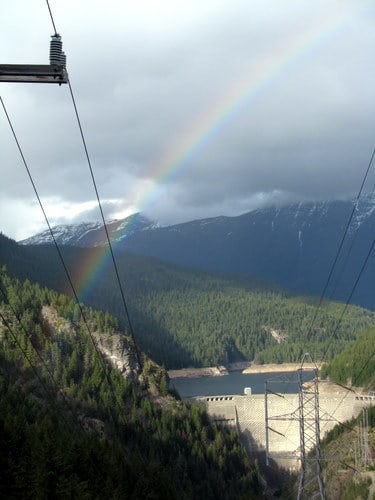
Harbinger—a presage, a foreshadow, to announce. Something that precedes and indicates the approach of something.
We all experience the wildness of the North Cascades differently. Each of us, in our own way, notices subtle details of the seasons changing in this ecosystem that others may miss completely. In order to tell a more beautiful story, paint a more vivid portrait, we must combine our individual details to articulate the true forms that nature takes in the beginning of spring.
Perhaps it is the calls and presence of varied thrushes in the neighboring forests. Maybe it is the emerging blossoms on cherry trees amidst farmland. Or perhaps it is a detailing so slight, understated, almost unnoticeable, that its mystery is its draw.
The staff and graduate students of North Cascades Institute‘s harbingers below announce the presence of spring in the North Cascades and Skagit Valley in a way that draws upon the communal knowledge of having lived in this place for decades to only several months. Each perspective is important to paint that vivid portrait, articulate that poetic story of spring.
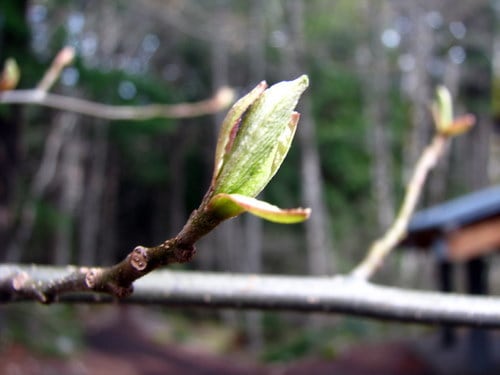 (Title) A rainbow across Ross Dam signals the coming of spring in the mountains (Above) Red alder leaves reach out from beneath bud casings at the Learning Center
(Title) A rainbow across Ross Dam signals the coming of spring in the mountains (Above) Red alder leaves reach out from beneath bud casings at the Learning Center
Lying in bed at first light, chickadees just beginning to sing. Paddling around Lake Padden in the evening, the songs of Swainson’s Thrushes unrolling from the forest like a dark ribbon. Indian plum blooming in the lowlands, late snows teasing the mountains. Starting to put together our Ski to Sea team, and dreaming of calypso orchids blooming at the Learning Center. — Saul Weisberg, Executive Director
Spring has always drifted into my awareness like a warm breeze, gentle and sweet, demanding the attention of all five senses. One of my favorite spring smells is resinous cottonwood buds. When I find one on the ground I like to take it apart and rub the sticky yellow sap on my skin so I can smell the honey sweetness the rest of the day. A spring sound that makes my heart do cartwheels is the warbling song of the Purple Finch, a regular visitor to my bird feeder. I welcome the tingly stinging feeling of my fingertips after picking stinging nettles for a healthful spring tea. I figure I can handle a little discomfort for all the nourishment the nettles give me. And finally, a favorite spring sight here in the northwest are the magenta pink salmonberry blossoms, which are also my favorite taste as well, so very much sweeter than the berries. — Heather Durham, Program Coordinator
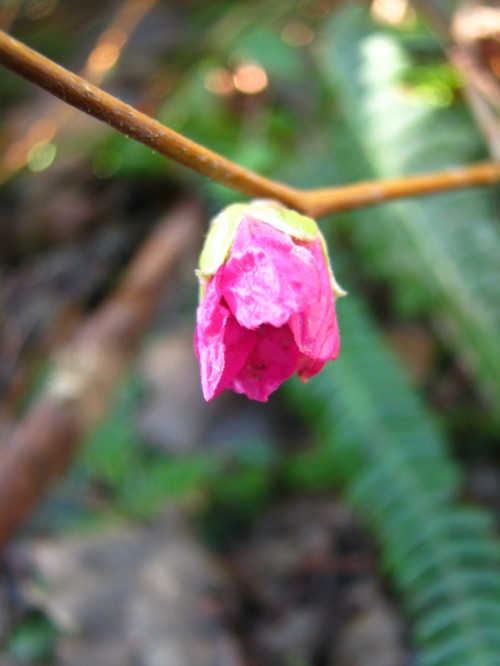 The vibrant pink of a salmonberry blossom stands out
The vibrant pink of a salmonberry blossom stands out
The inevitable spring snowstorm. It always hits after a long warm spell, when the lengthening of the days have created a buzz of excitement among my peers and I have packed up my winter boots and layers in anticipation. Only then does winter come back for one last hoorah, flaunting its power and beauty before letting the sun win for a few months. — Tanya Anderson, Graduate Program Coordinator
This is my very first spring here in the Pacific Northwest. As I have been watching closely the signs of spring creep up here to the Cascades, my most favorite sign comes from growing up in my home on Lake James in Virginia Beach, Virginia. As a child every March my dad would go down to the lake front and raise the purple martin houses. It was like clockwork every year. As soon as he would do so the martins would show up, one, two, and three at a time until the houses were full. Spring was officially here when I could sit down on our dock and watch them soar out of their holes over the water with displays of aerial acrobatics catching winged insects in flight. This is a sight that I will always be amazed with as long as I live. — Justin McWethy, Graduate Student
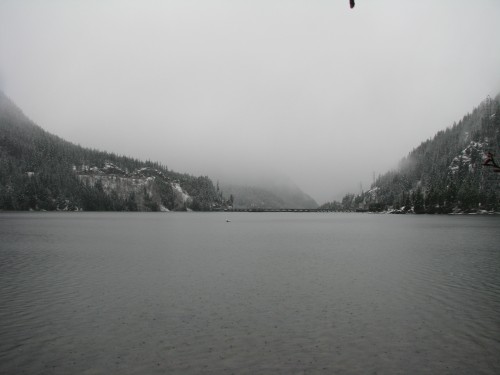 In March, the final snowstorms of winter fight for their position as spring comes
In March, the final snowstorms of winter fight for their position as spring comes
I know that spring is arriving when I hear the night time chorus of frog song and the morning sing song call of the chickadees. No matter the chill in the air, I then know that longer days and warmth are returning… and soon. — Deb Martin, Registrar
The way the light reflects off of the iron ore rust in the gorge at sunset is my sign that spring is coming! — Brandi Stewart, Graduate Student
I think that my harbinger, at least for this area-I have been here barely two seasons-is to the American Dipper cruising the banks of the Cascade River behind my house. I remember seeing it for my first time last spring, being truly amazed to see the little bird, no bigger than an avocado, diving into the swift rapids and reappearing from the stream sometimes several yards from where it had entered. Thinking of its short dives and its ability to swim and cling to rocks in powerful currents makes you really appreciate the abilities of an animal whose life work is simply to locate food. And, to do so in an environment so different from its natural environment, the sky. — Mike Cuseo, Learning Center Chef
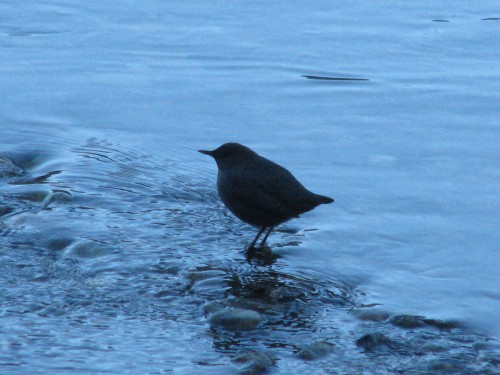 An American Dipper perches along a stream side in the North Cascades
An American Dipper perches along a stream side in the North Cascades
Being able to go canoeing at 5:30 in the evening and still have lots of light, warmth, and bird songs when I get back an hour later. — Ryan Weisberg, Seasonal Naturalist
I notice the coming of spring in a whole new way-as a way to connect with and utilize aspects of the natural world, through ethnobotany. Spring in the North Cascades begins when the black cottonwood bud casings start to fall beneath these large deciduous trees, making way for new leaves. Along with the leaf buds, these casings are a perfect start to a refreshing hand salve and a fresh perspective on spring in the mountains. — Kelsi Franzen, Graduate Student
My harbinger of spring was a new one in 2010. It is this heron who took up residency in my king apple tree. For an entire week in February he spent these late winter days perched less than 50 feet from my front door. Whenever we left the house, he would slowly turn his neck to look at us and then, as if he couldn’t be less interested, he would resume his stance staring out across the fields of Fir Island and the Skagit River. He moved on eventually, but he left us hopeful for sunny skies and blossoming trees. — Amy Wilcox, Development Director
 Hank the Heron perched in an apple tree in the Skagit Valley, Photo by Amy Wilcox
Hank the Heron perched in an apple tree in the Skagit Valley, Photo by Amy Wilcox
For me a harbinger of spring is when there is finally just enough light in the morning to go for a run before work. I love running early at this time of year because the birds are also starting to ramp up. When I’m tired I try running from one bird call to the next. — Brooke Larrabee, Development Coordinator
My favorite sign of spring are the bright green tips on the ends of trees. They remind me that the long summer days of golden light are soon to come. — Martine Mariott, Graduate Student
A harbinger of spring that has nearly physically accosted me is the occasional brilliant blast of clear sunshine. From the usually dreary and glum North Cascades skies erupts this bright blow of intense heat and light, lasting up to half an hour. It seems the sun knows it is eventually going to triumph and is picking a full-on fight. The clouds, however, are gathered at the edges of the bright blue patch and are holding themselves at full and imposing height. Snow on the mountainous heights is their calling card and, thus, they hold the high ground. — Corey White, Graduate Student
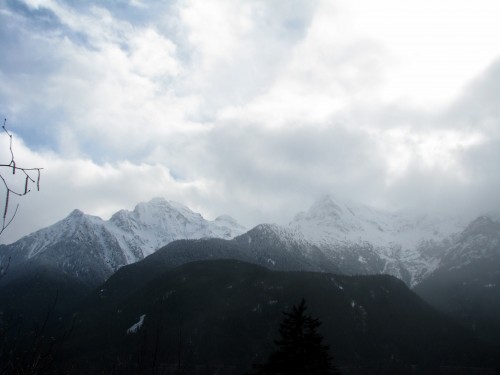 The sun attempts to burst through cloud cover over Pyramid & Colonial Peaks
The sun attempts to burst through cloud cover over Pyramid & Colonial Peaks
Being a South Florida native, the season spring never really meant more than having everything in sight covered in a coat of bright yellow pine pollen. Now, after these past few months, spring seems like some mythical superhero that will come and scoop us out of this dreary cold any day now. A harbinger of spring, or what I am expecting spring to be, is the folks of Seattle already sporting shorts and t-shirts while outside. To me, in my ga-jillion layers, they seem crazy and look cold. But, if dressing the part helps, get spring here faster and hand me my flip-flops! — Megan Magee, Graduate Student
The entrance of spring is noted by the straightening of shadows, no longer slanted across valleys but instead beaming down strong as the sun arcs above white peaks. Overjoyed and comforted by the warming rays, I relax upon a bed of moss in silence to listen to the harmonious buzz of Varied Thrushes and rediscover the habits of the American Robins. — Erin Fowler, Graduate Student
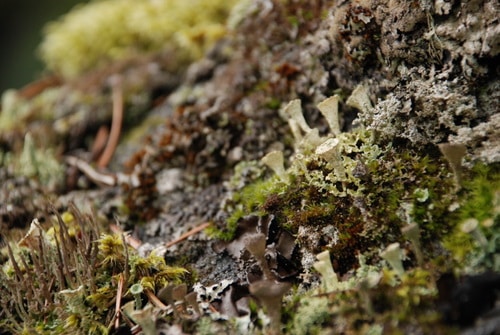 A bed of moss is an inviting spring sit spot, Photo by Erin Fowler
A bed of moss is an inviting spring sit spot, Photo by Erin Fowler
To me I recognize the coming of spring by evening mountain bike rides. There is nothing like being able to fit in extra activities after a long dark winter with the coming of longer days. — Mike Parelskin, Graduate Student
I knew it was spring when I saw the first slug in the grass. There are the usual things like robins and the blooming daffodils and trees, but somehow the humble slug stands out more strongly as being so singular. There was also the night I left work and the sun was shining through the notch at the end of Diablo Lake for the time time. That was very good. And the huge, single dandelion bloom in the backyard. I guess in the end it is the dandelions that are my favorite harbingers. Who can resist the exuberant cheer of gazillions of fluffy gold flowers? — Anne Hubka, Administrative Assistant
 Vine maple buds emerge surrounding the Learning Center’s many trails
Vine maple buds emerge surrounding the Learning Center’s many trails
Photos courtesy of Erin Fowler, Kelsi Franzen & Amy Wilcox.


This was a delight to read – thanks everyone for sharing – the visuals are wonderful! Looking forward to seeing Spring at NCI soon.
these are all so beautiful, spring awakes the poet in all of us!
I can’t wait to return to NCI again, your words and photographs reminds me what a truly special place it is.
This is one of my favorite posts ever here on Chattermarks! So great to hear a wide variety of voices talking about what they notice as the landscape awakens to spring, and wonderful to realize that different people notice different phenomenon with different senses. “Paying attention” = so vital! Thanks for this ode.
What great images. I am so glad spring has arrived your photos remind me of what a beautiful time of year it is and what a beautiful natural world we live in.